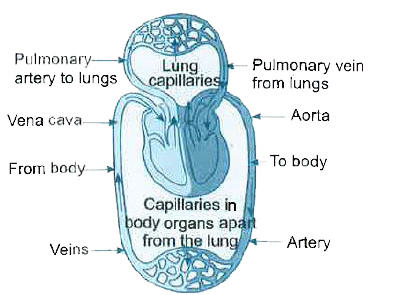The oxygenated and deoxygented blood is separate in the heart of mammals.
Reason (R) : This allows efficient supply of oxygen to all tissues.
Both assertion (A) and (R) are true and reason (R) is the correct explanation of assertion (A).
Both assertion (A) and reason (R) are true but reason (R) is not the correct explanation of assertion (A).
Assertion (A) is true but reason (R) is false.
Assertion (A) is false but reason (R) is true.
Step-by-Step Solution:
1. Understanding the Assertion: The assertion states that in mammals, the oxygenated and deoxygenated blood is separated in the heart. This is true as mammals possess a four-chambered heart, which includes two atria (auricles) and two ventricles.
2. Structure of the Mammalian Heart: The heart consists of:
- Right Atrium: Receives deoxygenated blood from the body.
- Right Ventricle: Pumps deoxygenated blood to the lungs for oxygenation.
- Left Atrium: Receives oxygenated blood from the lungs.
- Left Ventricle: Pumps oxygenated blood to the rest of the body.
3. Separation of Blood: In mammals, the design of the heart ensures that the oxygenated blood (from the left side) and deoxygenated blood (from the right side) do not mix. This separation occurs due to the distinct chambers of the heart.
4. Reasoning Behind the Assertion: The reason states that this separation allows for an efficient supply of oxygen to all tissues. This is accurate because:
- The separation ensures that tissues receive blood rich in oxygen without contamination from deoxygenated blood.
- Efficient oxygen delivery enhances cellular respiration and energy production in tissues.
5. Conclusion: Both the assertion and the reason are true, and the reason correctly justifies the assertion. Therefore, the answer to the question is that both the assertion and reason are true, and the reason supports the assertion.
Final Answer: Both the assertion and reason are true, and the reason correctly justifies the assertion.
---
- Right Atrium: Receives deoxygenated blood from the body.
- Right Ventricle: Pumps deoxygenated blood to the lungs for oxygenation.
- Left Atrium: Receives oxygenated blood from the lungs.
- Left Ventricle: Pumps oxygenated blood to the rest of the body.
- The separation ensures that tissues receive blood rich in oxygen without contamination from deoxygenated blood.
- Efficient oxygen delivery enhances cellular respiration and energy production in tissues.
Topper's Solved these Questions
- BOOK - OSWAL PUBLICATIONCHAPTER - LIFE PROCESSESEXERCISE - SELF-ASSESSMENT-2 (I. OBJECTIVE TYPE QUESTIONS) (D. VERY SHORT ANSWER TYPE QUESTIONS)3videos
LIFE PROCESSES
- BOOK - OSWAL PUBLICATIONCHAPTER - LIFE PROCESSESEXERCISE - SELF-ASSESSMENT-2 (II. SHORT ANSWER TYPE QUESTION)1videos
LIFE PROCESSES
- BOOK - OSWAL PUBLICATIONCHAPTER - LIFE PROCESSESEXERCISE - SELF-ASSESSMENT-2 (I. OBJECTIVE TYPE QUESTIONS) (B. PASSAGE/DIAGRAM BASED QUESTIONS)3videos
LIFE PROCESSES
- BOOK - OSWAL PUBLICATIONCHAPTER - HOW DO ORGANISMS REPRODUCE ?EXERCISE - CREATING BASED QUESTIONS6videos
HOW DO ORGANISMS REPRODUCE ?
- BOOK - OSWAL PUBLICATIONCHAPTER - MANAGEMENT OF NATURAL RESOURCES EXERCISE - CASE-BASED MCQs15videos
MANAGEMENT OF NATURAL RESOURCES
Similar Questions
Answer question numbers (a) - (d) on the basis of your understanding of the following paragraph and the related studied concepts :
The separation of the right side and the left side of the heart is useful to keep oxygenated and de-oxygenated blook from mixing. Such separation alllows a highly efficient supply of oxygen to the body. This is useful in animals that have high energy needs, such as birds and mammals, which constantly use energy to maintain their body temperature. In animals that do not use energy for this purpose, the body temperature depends on the temperature in the environment . Such animals, like amphibians or many reptiles have three- chambrered hearts, and tolerate some mixing of the oxygenated and de-oxygenated blood streams. Fishes, on the other hand, have only two chambers to their hearts, and the blood is pumped to the gills, is oxygenated there, and passes directly to the rest of the body.
(a) What does the give diagram depict ?
(b) In which type of organisms would you find this type of transportation ?
(c) Explain why some animals like fishes have only two chambered heart ?
(d) From this study what can you deduct about evolution ?
 View Solution
View SolutionWhy is it necessary to separate oxygenated and deoxygenated blood in mammals and birds ?
View Solution
Knowledge Check
- Question 1 - Select One
Mixing of oxygenated and deoxygenated blood occurs in the heart of
ABirdBCrocodileCRabbitDFrog - Question 2 - Select One
In mammals, oxygenated blood enters the heart at the
Aright atriumBleft atriumCright ventricleDleft ventricle - Question 3 - Select One
All arteries carry oxygenated blood except
ASystemicBhepaticCPulmonaryDCardiac nerve
All arteries carry oxygenated blood except
View SolutionOxygenated blood is transported from the heart to the tissues through
View SolutionAssertion : There is no mixing of oxygenated and deoxygenated blood in the human heart.
Reason : Valves are present in the heart which allows the movement of blood in one direction only.View SolutionOxygenated blood is carried to the heart by which of the following?
View SolutionAssertion : There is no mixing of oxygenated and deoxygenated blood in the human heart.
Reason : Valves are present in the heart which allows the movement of blood in one direction only.View Solution

